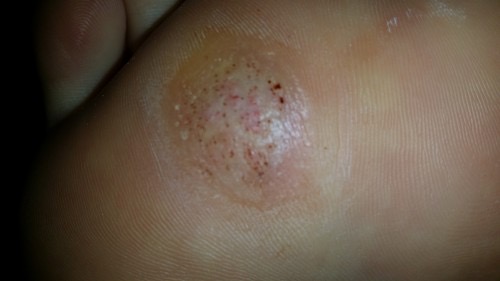Warts and Calluses

What are warts?
Warts are small grainy looking growths that usually occur on the fingers and/or hands. They are rough to the tough and sometimes have a pattern of tiny black dots. Those are actually tiny blood vessels.
What causes warts?
The most common warts are caused by a virus- the human papillomavirus (HPV) virus. One type causes warts on the hands and fingers, another type causes warts on the feet, and others cause warts on other areas of the body.
You can get warts if you touch people who have warts. You can also spread warts from one area of your own body to another. You can also get warts if you touch something that another person with warts has touched, like a towel or equipment at the gym. The virus enters your body through breaks in the skin. Children, young adults, and people with a lower immune system are most apt to develop warts.
What are the treatments?
Believe it or not, most warts will go away without any treatment, although it may take a year or two. Because they are so contagious, new warts may develop close to the older ones. For that reason, many people choose to have warts removed by a doctor.
Depending upon the location of the warts, there are several different treatments available. Some are used in combination with home treatments. Each treatment is designed to do two things:
- Destroy the wart
- Activate the immune system to fight the virus that caused the warts
Treatments include varying strengths of acids that cause layers of the wart to gradually come off, freezing the wart and laser treatments, although not all physicians agree with the effectiveness of lasers in this context.
If you or your children have warts come to see our physicians. We can treat them effectively and ensure that you build a strong immune system as well.
Plantar Warts

Plantar warts (verrucae) are caused by strains of the human papilloma virus (HPV). Plantar warts are skin lesions that usually occur on the bottom or plantar surface of the foot. Differentiating plantar warts from other skin lesions on the bottom of the foot can be difficult at times. Plantar warts occur in an estimated 7% – 10% of the population with a higher incidence in children.

Viruses are made up of genetic fragments encased in protein capable of inserting itself into a cell. Viruses bind to there target cells by latching on to certain receptors specific to the cell they are infecting, they then harness the cells genetic material to reproduce. During this process, they must trick our bodies cells into creating and feeding the cells infected by the virus, or the infection will not be successful and our bodies will battle the infection.
The viral infection increases the reproductive rate of the cells infected with the virus, so the virus releases factors calling for more blood supply, so new capillaries form. Because viruses infect our skin cells, we must kill the cells they infect in order to destroy the plantar warts.
There are two types of plantar warts – simple and mosaic. Simple warts have a single capillary feeding the infected dermal cells and are typically respond better to treatments. Mosaic warts are colonies of simple warts, there are multiple capillaries feeding the infected cells and difficult to resolve.
Diagnosing Plantar Warts
Diagnosing plantar warts can be difficult even for an experienced physician. There are other skin lesions that may have all or some of the common characteristics of plantar warts. Here are some key characteristics when diagnosing plantar warts:
- have small identifiable black dots called petechiae
- the normal skin lines
- Pain with lateral compression (pinching) the area
- Have thickened skin
